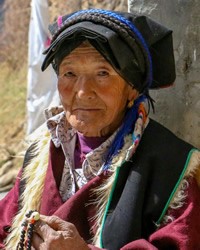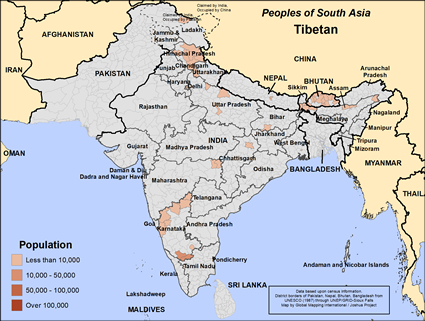Tibetan in India

Photo Source:
szyj351 - Pixabay
|

Map Source:
People Group data: Omid. Map geography: UNESCO / GMI. Map Design: Joshua Project
|
| People Name: | Tibetan |
| Country: | India |
| 10/40 Window: | Yes |
| Population: | 100,000 |
| World Population: | 1,104,400 |
| Primary Language: | Tibetan, Central |
| Primary Religion: | Buddhism |
| Christian Adherents: | 0.29 % |
| Evangelicals: | 0.15 % |
| Scripture: | Complete Bible |
| Ministry Resources: | Yes |
| Jesus Film: | Yes |
| Audio Recordings: | Yes |
| People Cluster: | Tibetan |
| Affinity Bloc: | Tibetan-Himalayan Peoples |
| Progress Level: |
|
Introduction / History
Tibet is known at "rooftop of the world." It is a mountainous landed located in southwestern China, just north of India. In 1950, the Chinese communists invaded Tibet. However, the Dalai Lama (religious and political ruler of Tibet) was permitted to remain their leader. While negotiations were being made between Tibetan and Chinese officials, Communist Chinese Party continued to oppress the Tibetans. In 1959, a revolt broke out in Lhasa, Tibet's capital. During the night, the Dalai Lama set out on a dangerous journey to India. His family, along with some cabinet members, personal officials, and bodyguards, fled with him. Thousands of Tibetans followed their leader and today, over 100,000 of them remain exiled in northern India. The Dalai Lama currently resides in Dharamsada, India and exercises his rule over Tibet as a government in exile.
What Are Their Lives Like?
Tibet is now one of China's "autonomous" regions, meaning it is a province of China controlled by a strong central government. The Tibetans are primarily concentrated in the northern portion of India where they continue to dream about the independent nation that once belonged to them. They speak Central Tibetan as their first tongue, but most also speak a local language like Hindi. Most of India's Tibetans are either farmers or nomadic shepherds. The farmers grow crops such as potatoes, wheat, barley, buckwheat, and vegetables. Farmers raise a wide variety of fruits in the short summers of the valleys of the Himalayan Mountains. Apricots are a staple fruit, and they even eat the pits. Butter tea is their favorite drink. The Tibetans in India live either in village clusters or in single family dwellings. The nomadic Tibetans live in tents and travel with their herds. They raise sheep, cattle, goats, and dzo (a cross between a yak and a cow). Dairy products and wool are important cash commodities. They are used for trading during the annual grain-trading expeditions or in various other distant markets. Not all Tibetans are farmers or shepherds. Some are lamas (monks) who live in monasteries and spend their time in prayer and meditation. Tibetans may also become artists and teachers, focusing mainly on religious arts and literature. Still others are private landowners or craftsmen. Traditional Tibetan skills include processing wool, grinding flour, working with metal, painting, and carpentry. Though these Tibetan emigrants are surrounded by Indian culture and traditions, Tibetan schools have been set up for their children to preserve their traditional culture and language. In India these Tibetans observe Buddhist ceremonies and holidays. Tibetan society is very "open" in nature. For example, polygamy and polyandry (one woman having multiple husbands) are common practices. Marriage is usually viewed as a non-religious joining of two families. Astrology and shamanistic practices play an important role in helping a young person to choose a mate. Tibetan women are responsible for rearing the children and preparing food. They are also allowed to take on responsibilities such as trade or agriculture if they wish. Tibetan women are not restricted merely to household duties.
What Are Their Beliefs?
Buddhism has been practiced in Tibet for hundreds of years, and many consider it their own religion. Buddhism is a major world religion based on the teachings of Siddhartha Gautama or the Buddha. He lived in the 6th and 5th century BC in ancient India. The Buddha taught the Four Noble Truths by which one can gain spiritual knowledge and escape the endless cycles of reincarnation. This is what Tibetans believe in theory, but in practice, they follow bon, a form of shamanism which is a central part of their lives. They also practice animism, a belief in the spirit world. In animism, evil spirits must be appeased through prayers, sacrifices and rituals. Two of the important Buddhist yearly holidays are Vesak, the Buddha's birthday celebrated in May or June and Bodhi Day, the holiday which commemorates the day that the historical Buddha experienced enlightenment under a Bodhi tree in December.
What Are Their Needs?
The Tibetans people in India must come to know that true peace, joy and forgiveness can only be found through knowing Christ. Teams of believers can bring the benefits of modern medicine and demonstrate the love of Christ to the Tibetans living in exile.
Prayer Points
Pray that God will move Indian Christians to reach out to their Tibetan neighbors. Ask God to encourage, protect and empower the tiny number of Tibetan believers to extend God's Kingdom in North India. Pray that Christian radio broadcasts will be made available in all Tibetan languages. Ask the Lord to raise up strong fellowships of believers among the Tibetan groups.